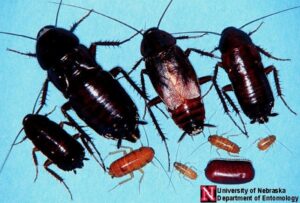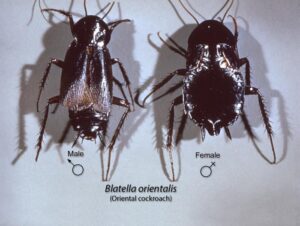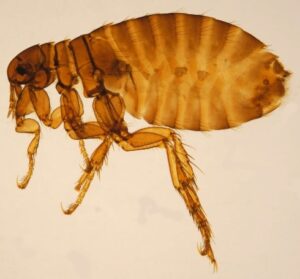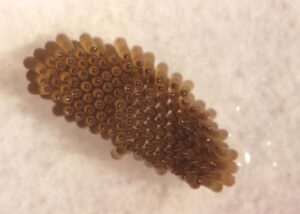Oriental Cockroach
General Description
Adult
- 5 cm (males) to 2.5 – 3.5 cm (females) long.
- Very dark brown to shiny black in color.
- Male wings are wide and short, leaving the last few abdominal segments exposed.
- Females are wingless, but have short triangular wing pads behind the pronotum.


Nymph
- Smaller than adults (size depends on how many molts they have been through).
- First stage nymphs are pale tan, all other nymph stages reddish brown to black in color and difficult to distinguish from American cockroach nymphs.
- Wingless.
Life Cycle and Common Characteristics:
- The Oriental cockroaches have a more seasonal life cycle than other cockroach pest species, with females producing eggs from spring to midsummer.
- The female carries an egg capsule for about 30 hours, after which it is either dropped or attached using saliva to a protected surface near a food supply.
- Females produce an average of 8 capsules, each containing 16 eggs, which hatch in about 60 days under room conditions.
- Nymphs molt 7 – 10 times and the nymphal stages take several months to a year to complete.
- This cockroach species has a seasonal developmental cycle. The high number appears in spring or early summer.
- Nymphs and adults have similar habits and are found associated with decaying organic matter indoors and out.
- Adults can live about one month without food and up to two weeks without water.
- Adults do not fly.
- Orientals prefer moist areas near or below ground level.
- These cockroaches are poor climbers and are rarely seen on walls or ceilings.
- They favor areas with decaying organic matter, such as sewers, drains, landfills, and mulch beds.
- In buildings, they often inhabit damp basements, lower areas of pipe chases, steam tunnels, boiler rooms, pools, and locker rooms.
- They can travel through such areas to migrate from one part of a building to another.
- They can survive in cooler temperatures than other common cockroach pests and often enter a building through the floor drains.
- Oriental cockroaches favor decaying organic matter and starchy food materials. They feed on rubbish and are often found outdoors near dumpsters or around building perimeters. The adults can live about one month without food and up to two weeks without water.
Damage and Medical Implications
- Cockroaches can be detected by their obnoxious odor or damage, or by the fecal matter (called frass) that they produce or deposit. These clues can aid in diagnosing a cockroach problem.
- Cockroaches are unlikely to bite humans because their mouthparts are not large or powerful enough to inflict a “bite”.
- The cockroach damage is a result of their habit of feeding and harboring in damp and unsanitary places, such as sewers, garbage disposals and damp and unsanitary areas of kitchens, bathrooms and indoor storage areas.
- Cockroaches spread filth and germs from these sources onto food supplies, food preparation surfaces, dishes, utensils and other surfaces.
- Cockroaches contaminate far more food than they eat.
- Because of the odor imparted by cockroaches, most people are disgusted and repulsed by their presence.
- Cockroaches produce odorous secretions from various points in their bodies, and these secretions can affect the flavor of foods.
- The presence of cockroaches constitutes an important source of health-threatening allergens and can even trigger life-threatening asthma attacks.
- Different forms of gastroenteritis potentially may be diseases transmitted by cockroaches. These include salmonella food poisoning, nausea, abdominal cramps, vomiting, diarrhea, dysentery and other illnesses. The organisms causing these diseases are carried on the legs and bodies of cockroaches, and are deposited on food and utensils as cockroaches forage.
- Cockroach excrement and cast skins contain a number of allergens to which many people exhibit allergic responses, such as skin rashes, watery eyes and sneezing.
- Cockroaches are not associated with severe illnesses or disease outbreaks.




